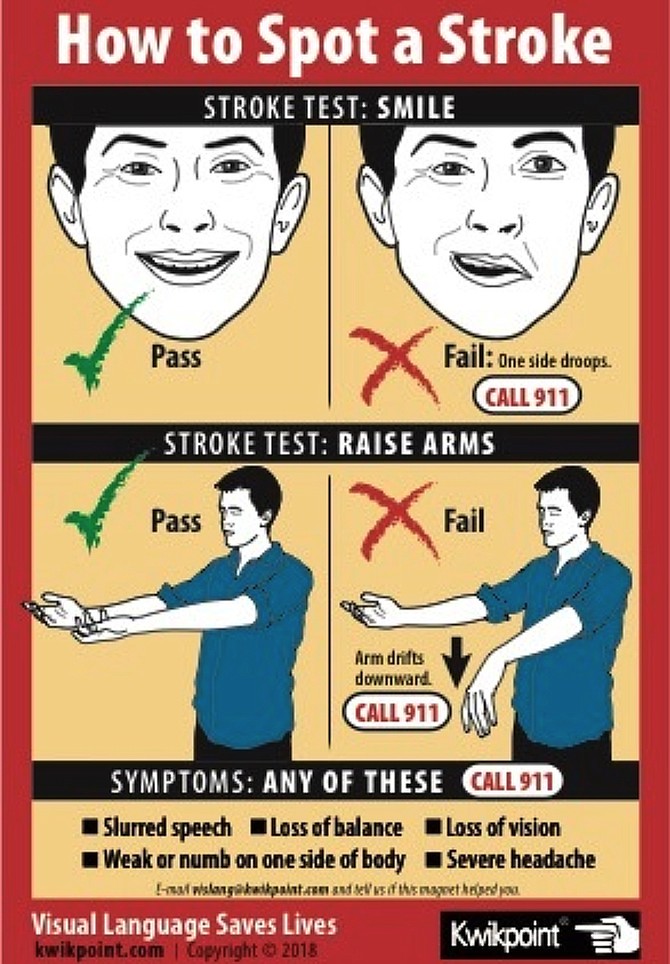Odds are you know someone who has had a stroke or is a caregiver to a stroke patient. In fact, stroke affects 80 percent of all families and is a leading cause of death and disability. The lifetime risk of stroke is 1 in 5 for women, 1 in 6 for men. Those odds increase even more for those with certain risk factors like smoking and high blood pressure.
Strokes exact a heavy toll on individuals and families. In October 2017, Mayor Allison Silberberg proclaimed a city-wide health campaign to protect our community from the devastation caused by stroke. The goal of Stroke Smart Alexandria (SSA) is to educate every person who lives, works and regularly spends time in Alexandria on how to spot a stroke and how critical it is to stroke survival to call 911 immediately.
Life-saving treatments are available to stroke victims but they are all time-sensitive. A clot-buster called t-PA, for example, can be given to restore blood flow to the brain. However, it must be administered within 3-4 hours of onset of stroke symptoms. Unfortunately, less than 10 percent of people who are eligible for t-PA get to a hospital within the time window. Even more advanced treatments are available these days, but because the vast majority of people do not know how to spot a stroke and the importance of calling 911 as soon as the symptoms are recognized, many stroke victims tragically missed the chance for recovery, even survival.
Alexandria is fortunate to have one of the best primary stroke centers in the country. INOVA Alexandria Hospital has been awarded the Joint Commission’s Gold Seal of Approval for stroke care, and recognized for its outstanding specialized stroke treatment by the American Stroke Association (ASA). While our local hospitals have made impressive improvements in reducing the door-to-needle time, it is now up to us, Alexandrians, to lower the onset-to-911 time to help those struck down get the best chance of survival and recovery.
To educate Alexandrians to recognize the signs of a stroke, Stroke Smart Alexandria is making available free educational materials around our city. Pictured at left is a specially designed visual tool to help everyone learn and remember the signs of a stroke. The tool is available in the forms of tear-and-waterproof wallet cards, stickers, refrigerator magnets, and posters, available for free at the following locations: City Hall; INOVA Alexandria; Giant Pharmacies and Neighborhood Pharmacy; Libraries; Recreation Centers; Starbucks with bulletin boards; Senior Services of Alexandria, and City Clinics; Christ Church Alexandria; Goodwin House; Immanuel on the Hill; and Watergate at Landmark.
Because most people who are suffering a stroke have difficulty calling 911 themselves, it is important to educate the people around you on how to spot a stroke. Every Alexandrian is encouraged to learn and remember the signs of stroke, and to distribute the stroke visual tool to friends and family. By spreading the word, you may just save your own life or someone else’s.
In his TED Talk, Alan Stillman, a 30-year resident of Alexandria, shares his personal story of watching helplessly his grandmother Rose suffer a stroke, and being left alone in the world at a young age without a family after eventually losing Rose. Knowing the personal cost of the disease, he started the Spot-a-Stroke, Stop-a-Stroke, Save-a-Life campaign to raise stroke awareness among the public. His TED Talk can be viewed at tinyurl.com/SpotStroke. Beginning with Stroke Smart Alexandria in his hometown, Stillman hopes to eventually get the ear of Gov. Ralph Northam and take the campaign to the state level. If you have ideas on how to spread the word or want to help, contact Stillman at Alan@kwikpoint.com.
